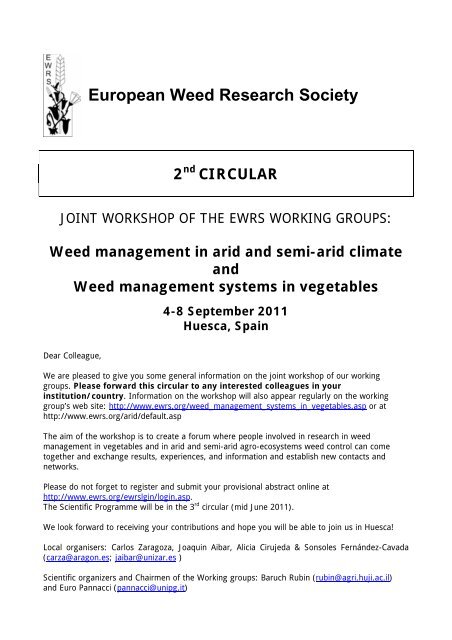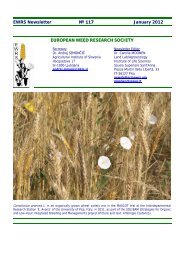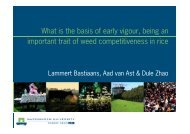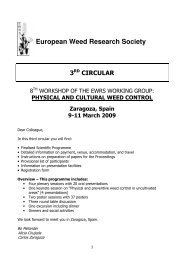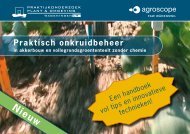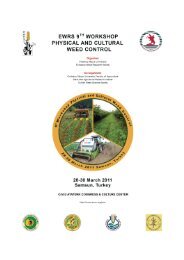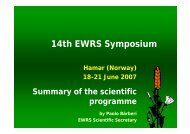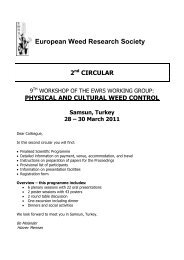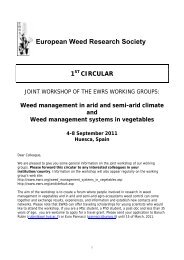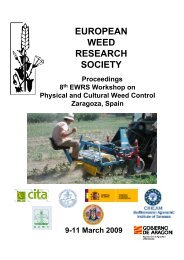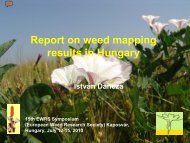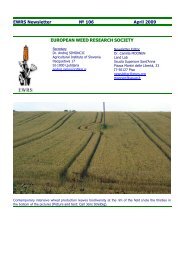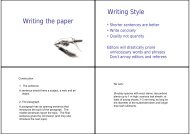Weed management in arid and semi-arid climate & Weed ...
Weed management in arid and semi-arid climate & Weed ...
Weed management in arid and semi-arid climate & Weed ...
You also want an ePaper? Increase the reach of your titles
YUMPU automatically turns print PDFs into web optimized ePapers that Google loves.
European <strong>Weed</strong> Research Society<br />
2 nd CIRCULAR<br />
JOINT WORKSHOP OF THE EWRS WORKING GROUPS:<br />
<strong>Weed</strong> <strong>management</strong> <strong>in</strong> <strong>arid</strong> <strong>and</strong> <strong>semi</strong>-<strong>arid</strong> <strong>climate</strong><br />
<strong>and</strong><br />
<strong>Weed</strong> <strong>management</strong> systems <strong>in</strong> vegetables<br />
Dear Colleague,<br />
4-8 September 2011<br />
Huesca, Spa<strong>in</strong><br />
We are pleased to give you some general <strong>in</strong>formation on the jo<strong>in</strong>t workshop of our work<strong>in</strong>g<br />
groups. Please forward this circular to any <strong>in</strong>terested colleagues <strong>in</strong> your<br />
<strong>in</strong>stitution/country. Information on the workshop will also appear regularly on the work<strong>in</strong>g<br />
group’s web site: http://www.ewrs.org/weed_<strong>management</strong>_systems_<strong>in</strong>_vegetables.asp or at<br />
http://www.ewrs.org/<strong>arid</strong>/default.asp<br />
The aim of the workshop is to create a forum where people <strong>in</strong>volved <strong>in</strong> research <strong>in</strong> weed<br />
<strong>management</strong> <strong>in</strong> vegetables <strong>and</strong> <strong>in</strong> <strong>arid</strong> <strong>and</strong> <strong>semi</strong>-<strong>arid</strong> agro-ecosystems weed control can come<br />
together <strong>and</strong> exchange results, experiences, <strong>and</strong> <strong>in</strong>formation <strong>and</strong> establish new contacts <strong>and</strong><br />
networks.<br />
Please do not forget to register <strong>and</strong> submit your provisional abstract onl<strong>in</strong>e at<br />
http://www.ewrs.org/ewrslg<strong>in</strong>/log<strong>in</strong>.asp.<br />
The Scientific Programme will be <strong>in</strong> the 3 rd circular (mid June 2011).<br />
We look forward to receiv<strong>in</strong>g your contributions <strong>and</strong> hope you will be able to jo<strong>in</strong> us <strong>in</strong> Huesca!<br />
Local organisers: Carlos Zaragoza, Joaqu<strong>in</strong> Aibar, Alicia Cirujeda & Sonsoles Fernández-Cavada<br />
(carza@aragon.es; jaibar@unizar.es )<br />
Scientific organizers <strong>and</strong> Chairmen of the Work<strong>in</strong>g groups: Baruch Rub<strong>in</strong> (rub<strong>in</strong>@agri.huji.ac.il)<br />
<strong>and</strong> Euro Pannacci (pannacci@unipg.it)
JOINT WORKSHOP OF THE EWRS WORKING GROUPS:<br />
<strong>Weed</strong> <strong>management</strong> <strong>in</strong> <strong>arid</strong> <strong>and</strong> <strong>semi</strong>-<strong>arid</strong><br />
<strong>climate</strong><br />
&<br />
<strong>Weed</strong> <strong>management</strong> systems <strong>in</strong> vegetables<br />
Huesca, 4-8 September 2011<br />
Venue<br />
The Workshop will take place at the Escuela Politécnica Superior de Huesca, located 7 km from the<br />
centre of Huesca. Huesca is an ancient town of 50.000 <strong>in</strong>habitants with very <strong>in</strong>terest<strong>in</strong>g<br />
architecture, especially from its Romanesque period. It is one of the three capitals of the Aragón<br />
region. The city lays on the road to France about 75 km from Zaragoza. It is serviced by few<br />
airl<strong>in</strong>es but frequent tra<strong>in</strong>s <strong>and</strong> buses are available from both Madrid <strong>and</strong> Barcelona. Huesca is<br />
located next to the Pyrenees mounta<strong>in</strong>s, which def<strong>in</strong>es the l<strong>and</strong>scape of the Hoya (valley) of<br />
Huesca, an important agricultural region which <strong>in</strong>cludes dryl<strong>and</strong> <strong>and</strong> irrigated crops. This is an<br />
area of large contrasts between the rocky mounta<strong>in</strong>s <strong>and</strong> the <strong>arid</strong> surround<strong>in</strong>gs with scarce<br />
vegetation. The location of the venue offers an excellent opportunity for you to spend some extra<br />
days sightsee<strong>in</strong>g <strong>in</strong> the Pyrenees or visit<strong>in</strong>g the two major cities of Spa<strong>in</strong>, Barcelona <strong>and</strong> Madrid,<br />
with all their <strong>in</strong>terest<strong>in</strong>g attractions (http://www.huescaturismo.com).<br />
Several <strong>in</strong>stitutions are co-operat<strong>in</strong>g with the EPS of Huesca: Centro de Investigación y Tecnología<br />
Agroalimentaria (CITA) (a regional Research Centre <strong>in</strong> Food <strong>and</strong> Agriculture), a delegation of the<br />
Consejo Superior de Investigaciones Científicas (CSIC) (the ma<strong>in</strong> Research Institution of Spa<strong>in</strong>),<br />
the Plant Protection Service from the Autonomous Government <strong>and</strong> different laboratories of the<br />
Agriculture Department of Aragón.<br />
Accommodations <strong>and</strong> meals<br />
Participants <strong>in</strong> the workshop will have lunch at the EPS restaurant. Accommodations will be <strong>in</strong><br />
Huesca, <strong>and</strong> a list of recommended hotels <strong>in</strong> the city centre is provided below. The central location<br />
of the hotels will facilitate meet<strong>in</strong>g after the official programme. We hope that <strong>in</strong>formal discussions<br />
will cont<strong>in</strong>ue while enjoy<strong>in</strong>g some ‘tapas’ <strong>in</strong> many of the bars of the old city.<br />
Hotels between 65 <strong>and</strong> 70 euro / night <strong>in</strong>clud<strong>in</strong>g breakfast<br />
Abba (the closest to the bus station)<br />
http://www.abbahuescahotel.com/<br />
Hotel Pedro I de Aragón<br />
http://www.hotelpedroidearagon.com/<br />
Hotel Posada de la Luna<br />
http://www.posadadelaluna.com/<br />
Hotels between 80-90 euros / night <strong>in</strong>clud<strong>in</strong>g breakfast<br />
http://www.hotelsanchoabarca.com/<br />
Student Residence<br />
Colegio Mayor Ramon Ac<strong>in</strong><br />
Double rooms with shared bath <strong>and</strong> without breakfast: 18.08 EUR / night<br />
Book here as soon as possible, contact: Joaqu<strong>in</strong> Aibar ( jaibar@unizar.es)<br />
2
How to reach Huesca:<br />
Airports:<br />
• Airport "Huesca Pir<strong>in</strong>eos", is located just 10 km from Huesca, but with very few flights.<br />
• At about 45 m<strong>in</strong>utes (driv<strong>in</strong>g) from our city is the airport of Zaragoza with more flights.<br />
• Barajas (Madrid) <strong>and</strong> El Prat (Barcelona) <strong>in</strong>ternational airports with abundant rail networks.<br />
By road:<br />
From Zaragoza to Huesca: take the A-23 free motorway.<br />
From Madrid: take the A-2 free motorway direction Zaragoza- Barcelona <strong>and</strong> cont<strong>in</strong>ue with the A-<br />
23 to Huesca.<br />
From Barcelona: take the toll motorway to Zaragoza <strong>and</strong> cont<strong>in</strong>ue on the A-23 to Huesca.<br />
3
By bus:<br />
From Delicias Intermodal Station <strong>in</strong> Zaragoza:<br />
• Regular bus services from ma<strong>in</strong> Spanish cities: Zaragoza (every half an hour), Barcelona, Lérida<br />
(Lleida) <strong>and</strong> Pamplona.<br />
• Time schedule <strong>and</strong> prices for Zaragoza -Huesca trip: http://www.alosa.es/rutas-horarios-precios/<br />
Attention! Check the summer schedule.<br />
By tra<strong>in</strong><br />
From Delicias Intermodal Station (same station of the buses):<br />
• Regular services of RENFE (Spanish Railways), with a daily shuttle l<strong>in</strong>e (AVE) from Zaragoza to<br />
Huesca (44 m<strong>in</strong>utes). There are also many regular tra<strong>in</strong>s from Zaragoza to Huesca (about 1<br />
hour). Currently, there are 7 tra<strong>in</strong>s between 6:59 <strong>and</strong> 20:44. Attention! Check the summer<br />
schedule.<br />
• The AVE tra<strong>in</strong>s from Madrid to Zaragoza (1 hour <strong>and</strong> a half) <strong>and</strong> from Barcelona to Zaragoza (1<br />
hr average) are very frequent (11/ day). There is only a direct tra<strong>in</strong> Madrid-Huesca at 19:05<br />
(takes about 2 hr). AVE tra<strong>in</strong>s are fast but rather expensive.<br />
• Tra<strong>in</strong> book<strong>in</strong>gs (also <strong>in</strong> English): http://www.renfe.com/viajeros/<strong>in</strong>dex.html<br />
We recommend:<br />
Book directly <strong>in</strong> Hotel ABBA Huesca (best quality/price ratio). If you arrive at the Madrid airport:<br />
try to get the AVE tra<strong>in</strong> directly to Huesca. If you miss it, then take the AVE tra<strong>in</strong> to Zaragoza <strong>and</strong><br />
another tra<strong>in</strong> or bus to Huesca. If you arrive at the Barcelona airport: get the AVE tra<strong>in</strong> to<br />
Zaragoza <strong>and</strong> then cont<strong>in</strong>ue by tra<strong>in</strong> or bus to Huesca.<br />
Another possibility is to rent a car <strong>in</strong> the Zaragoza station <strong>and</strong> drive to Huesca. This is expensive<br />
but faster. It can be cheaper if you share the car with other colleagues.<br />
Meet<strong>in</strong>g fees:<br />
The fees <strong>in</strong>clude welcome party, lunches dur<strong>in</strong>g the meet<strong>in</strong>g days <strong>and</strong> farewell <strong>in</strong>formal d<strong>in</strong>ner.<br />
Before June 30 : EWRS members <strong>and</strong> students: 150 €. Non EWRS members: 210 € (<strong>in</strong>cludes the<br />
equivalent of the EWRS membership fee for one year i.e. 60 € <strong>in</strong> 2011). After June 30: EWRS<br />
members: 180 €. Non EWRS members: 235 €<br />
Please send the fee with the name: "Meet<strong>in</strong>g EWRS Huesca", <strong>in</strong>clud<strong>in</strong>g clearly your name to this<br />
bank account number: IBAN: ES37 2086 0047 3533 0012 0238 (BIC: CECAESMM086)<br />
Provisional programme (to be adjusted accord<strong>in</strong>g to the submitted contributions etc…)<br />
Sunday 4th September 2011<br />
Arrival, sightsee<strong>in</strong>g, etc.<br />
Afternoon <strong>and</strong> Even<strong>in</strong>g: Registration<br />
Welcome dr<strong>in</strong>k <strong>and</strong> d<strong>in</strong>ner on your own<br />
Monday 5th September 2011<br />
Morn<strong>in</strong>g: Registration<br />
Morn<strong>in</strong>g <strong>and</strong> afternoon: Scientific programme<br />
Even<strong>in</strong>g: D<strong>in</strong>ner on your own<br />
Tuesday 6th September 2011<br />
Morn<strong>in</strong>g: Registration<br />
Morn<strong>in</strong>g <strong>and</strong> afternoon: Scientific programme<br />
Even<strong>in</strong>g: D<strong>in</strong>ner on your own<br />
4
Wednesday 7th September 2011<br />
Morn<strong>in</strong>g: Scientific programme<br />
Afternoon: Scientific programme<br />
Even<strong>in</strong>g: Farewell d<strong>in</strong>ner.<br />
Thursday 8th September 2011<br />
Morn<strong>in</strong>g: Plans for the future <strong>and</strong> conclud<strong>in</strong>g remarks (workshop ends at approx. 13:00)<br />
Scientific programme<br />
As usual, the workshop aims to be <strong>in</strong>formal <strong>and</strong> to stimulate as much discussion as possible<br />
among participants. As <strong>in</strong> past workshops, we will comb<strong>in</strong>e plenary scientific sessions with oral <strong>and</strong><br />
poster presentations, concurrent round-table discussions, <strong>and</strong> a f<strong>in</strong>al plenary session (reports on<br />
round-table discussions, directions for the future, etc.). Session chairs will briefly <strong>in</strong>troduce each<br />
poster associated with the theme of their oral session presentations. We would also like to<br />
organise some keynote themes presented by <strong>in</strong>vited speakers. This will be followed by an<br />
extensive discussion last<strong>in</strong>g 30-45 m<strong>in</strong>. You are welcome to suggest relevant speakers <strong>and</strong><br />
themes.<br />
Below is a tentative list of topics:<br />
<strong>Weed</strong> biology, ecology <strong>and</strong> modell<strong>in</strong>g<br />
Herbicide behaviour <strong>in</strong> soils<br />
Invasive weeds: control <strong>and</strong> quarant<strong>in</strong>e regulations<br />
<strong>Weed</strong> <strong>management</strong> <strong>in</strong> organic farm<strong>in</strong>g systems<br />
Preventive <strong>and</strong> <strong>in</strong>tegrated weed control (crop rotation, tillage system, false seedbed technique,<br />
seed<strong>in</strong>g rate, fertilisation, etc.)<br />
Irrigation <strong>and</strong> weed control<br />
<strong>Weed</strong> <strong>management</strong> <strong>in</strong> m<strong>in</strong>or crops <strong>and</strong> special situations<br />
Cover crops, mulches <strong>and</strong> <strong>in</strong>tercropp<strong>in</strong>g<br />
New developments <strong>and</strong> technical <strong>in</strong>novations<br />
<strong>Weed</strong> population dynamics <strong>in</strong> physical <strong>and</strong> cultural weed <strong>management</strong> systems<br />
Parasitic weeds <strong>and</strong> herbicide resistance<br />
Environmental impact of weed <strong>management</strong><br />
Research methodology <strong>in</strong> weed <strong>management</strong><br />
<strong>Weed</strong> control <strong>and</strong> UE agro- environmental schemes<br />
Exchange <strong>and</strong> transfer of <strong>in</strong>formation, <strong>and</strong> <strong>in</strong>ternational cooperation (glossary, use of Internet<br />
resources, etc.)<br />
...<br />
Abstracts <strong>and</strong> Proceed<strong>in</strong>gs<br />
A booklet with one-page abstracts of all scientific contributions will be available at the<br />
workshop.<br />
The abstracts <strong>and</strong> optional full papers of all scientific contributions, both oral <strong>and</strong> poster<br />
papers, will appear <strong>in</strong> the Proceed<strong>in</strong>gs, which will be published on each work<strong>in</strong>g group’s web<br />
page after the workshop.<br />
5
Important dates <strong>and</strong> deadl<strong>in</strong>es (please take note):<br />
31 st May 2011<br />
Deadl<strong>in</strong>e for pre-registration <strong>and</strong> provisional abstracts submission (onl<strong>in</strong>e only,<br />
through the web site: http://www.ewrs.org/ewrslg<strong>in</strong>/log<strong>in</strong>.asp)<br />
15 th June 2011<br />
Third Circular conta<strong>in</strong><strong>in</strong>g:<br />
F<strong>in</strong>al Scientific Programme<br />
Provisional list of participants<br />
Additional <strong>in</strong>formation on site, travel, etc if necessary.<br />
15 th July 2011<br />
Deadl<strong>in</strong>e for submission of f<strong>in</strong>al abstracts <strong>and</strong> optional full papers for the Proceed<strong>in</strong>gs.<br />
Deadl<strong>in</strong>e for payment of workshop fee<br />
Organis<strong>in</strong>g committee<br />
Scientific organisers<br />
Dr. Baruch Rub<strong>in</strong>, J & R Liss Professor of Agronomy & <strong>Weed</strong> Science,<br />
Institute of Plant Sci. & Genetics <strong>in</strong> Agriculture<br />
RH Smith Faculty of Agriculture, Food <strong>and</strong> Environment<br />
The Hebrew University of Jerusalem. Rehovot 76100, Israel<br />
Phone: ++972-(0)8-948-9248 Fax: ++972-(0)8-936-2083 Mobile: ++972(0)54-8820054<br />
E-mail: rub<strong>in</strong>@agri.huji.ac.il<br />
Dr. Euro Pannacci<br />
University of Perugia<br />
Dept of Agricultural <strong>and</strong> Environmental Sciences<br />
Borgo XX Giugno, 74 06121, Perugia - Italy<br />
Phone: +39 075 5856342 Fax: +39 075 5856344<br />
E-mail: pannacci@unipg.it<br />
Dr. Joaquín Aibar (Escuela Politécnica Superior de Huesca, University of Zaragoza, Spa<strong>in</strong>)<br />
(jaibar@aragon.es )<br />
Dr. Alicia Cirujeda & Dr.Carlos Zaragoza (Centro de Investigación y Tecnología Agroalimentaria<br />
(CITA), Zaragoza, Spa<strong>in</strong>) (acirujeda@aragon.es; carza@aragon.es )<br />
Local organisers<br />
A.Cirujeda & C. Zaragoza (Centro de Investigación y Tecnología Agroalimentaria (CITA),<br />
Zaragoza, Spa<strong>in</strong>)<br />
J. Aibar (Escuela Politécnica Superior de Huesca, University of Zaragoza, Spa<strong>in</strong>)<br />
S. Fernández-Cavada (Centro de Protección Vegetal, Diputación General de Aragón, Zaragoza,<br />
Spa<strong>in</strong>) (sfern<strong>and</strong>ez-cavada@aragon.es )<br />
6
Instructions for the preparation of<br />
abstracts <strong>and</strong> papers for the proceed<strong>in</strong>gs<br />
Abstracts are m<strong>and</strong>atory for all authors.<br />
The f<strong>in</strong>al formatt<strong>in</strong>g <strong>and</strong> changes <strong>in</strong> font size for paragraphs <strong>and</strong> various head<strong>in</strong>gs will be done by<br />
the editor.<br />
General <strong>in</strong>structions:<br />
Word processor: If at all possible, please submit your text <strong>in</strong> a PC compatible format, us<strong>in</strong>g either<br />
WordPerfect for W<strong>in</strong>dows (version 6 or up) or Microsoft Word for W<strong>in</strong>dows (.doc not<br />
.docx). Otherwise, save your text as a RTF file (rich text format).<br />
Paper format: A4 (210 x 297 mm)<br />
Page marg<strong>in</strong>s: 20 mm on every side except for the top where the marg<strong>in</strong> is 30 mm<br />
L<strong>in</strong>e spac<strong>in</strong>g: S<strong>in</strong>gle space<br />
Font: Times New Roman<br />
Font size: 12 pt. everywhere <strong>in</strong> the text, <strong>in</strong>clud<strong>in</strong>g head<strong>in</strong>gs, title, etc. Text <strong>in</strong> the tables can be smaller<br />
to make it fit but no less than 8 pt. Superscript <strong>and</strong> subscript can be used anywhere.<br />
Text justification: Left justified everywhere, for all the text, title, authors, etc<br />
Page number<strong>in</strong>g: NONE<br />
Headers, footers: NONE<br />
Lat<strong>in</strong> names: Use italics for Lat<strong>in</strong> names. Do not underl<strong>in</strong>e. Use common names for crops <strong>and</strong> Lat<strong>in</strong> names<br />
for weeds. Common names for weeds may be <strong>in</strong>dicated <strong>in</strong> parenthesis after the first mention<br />
of the Lat<strong>in</strong> b<strong>in</strong>omial.<br />
Paragraphs: No <strong>in</strong>dentation<br />
Between paragraphs: Insert a blank l<strong>in</strong>e between paragraphs<br />
Head<strong>in</strong>gs: Four levels of head<strong>in</strong>g can be used. All <strong>in</strong> Times Roman at 12 pt.<br />
- The first level is bold, preceded <strong>and</strong> followed by a blank l<strong>in</strong>e<br />
- The second level is <strong>in</strong> italics, preceded by a blank l<strong>in</strong>e<br />
- The third level is underl<strong>in</strong>ed, preceded by a blank l<strong>in</strong>e<br />
- The fourth level is underl<strong>in</strong>ed <strong>and</strong> <strong>in</strong> italics, preceded by a blank l<strong>in</strong>e<br />
Measurement units: St<strong>and</strong>ard <strong>in</strong>ternational units should be used<br />
Space preced<strong>in</strong>g <strong>and</strong> follow<strong>in</strong>g various head<strong>in</strong>gs: One blank l<strong>in</strong>e<br />
Insert only one s<strong>in</strong>gle blank space after a full stop <strong>in</strong> a sentence.<br />
File name: Please note that you must use file names that are <strong>in</strong>formative when submitt<strong>in</strong>g your abstract or full<br />
paper. When submitt<strong>in</strong>g your text, please use you name <strong>and</strong> use underscore ( _ ) between words.<br />
Example:<br />
Bo_Mel<strong>and</strong>er.doc. If you submit more than 1 file, use numbers. Example:<br />
Bo_Mel<strong>and</strong>er_1.doc, etc.<br />
Abstracts:<br />
M<strong>and</strong>atory for all authors is the submission of a one-page abstract for each oral or poster presentation. These abstracts<br />
will appear <strong>in</strong> the hard-copy booklet that will be distributed at the workshop <strong>and</strong> also <strong>in</strong> the proceed<strong>in</strong>gs of the<br />
workshop. Your text must conform to the general <strong>in</strong>structions above <strong>and</strong> to the follow<strong>in</strong>g <strong>in</strong>structions:<br />
Head<strong>in</strong>gs: No more than two levels<br />
Tables <strong>and</strong> figures: Should be avoided <strong>in</strong> the abstracts<br />
References: Maximum of three references should appear <strong>in</strong> the abstracts.<br />
7
Example of an abstract<br />
(text truncated, used for illustration purposes only, one extra name<br />
was added after Pullen):<br />
Comparison of alternative <strong>in</strong>terrow weeder steer<strong>in</strong>g systems<br />
D.W.M. Pullen 1 , A.N. Addedname 1 <strong>and</strong> P.A. Cowell 2<br />
1 Cranfield University at Silsoe, Silsoe, Bedford MK45 4DT, UK Email: d.pullen@cranfield.ac.uk<br />
2 Consultant, formerly with Cranfield Univesity at Silsoe<br />
The success of <strong>in</strong>terrow weed<strong>in</strong>g depends on be<strong>in</strong>g able to quickly <strong>and</strong> accurately guide the weeder<br />
along the rows. This can only be done by automatically guid<strong>in</strong>g the weeder. Any automatic weeder<br />
steer<strong>in</strong>g system requires a sensor/s to provide an error or guidance signal <strong>and</strong> a mechanism to move<br />
the hoes to the correct lateral position at the correct time ……….<br />
Results of the study show the modell<strong>in</strong>g technique was accurate. The amplitude of the predicted<br />
weeder path was with<strong>in</strong> 2% <strong>and</strong> the phase angle with<strong>in</strong> 2 degrees of the actual value. 1The study<br />
also suggests fitt<strong>in</strong>g steered wheels, whose position moved proportionally with the error signal was<br />
overall the most suitable method of steer<strong>in</strong>g the weeder. For this steer<strong>in</strong>g system the model shows<br />
the critical parameters affect<strong>in</strong>g overall performance were the steer<strong>in</strong>g ga<strong>in</strong> <strong>and</strong> hoe position. The<br />
tractor type (ICR position), the sens<strong>in</strong>g position, the steered wheel position <strong>and</strong> steered wheel axle<br />
position did not significantly <strong>in</strong>fluence performance. However, position<strong>in</strong>g the steered wheels<br />
beh<strong>in</strong>d the headstock but <strong>in</strong> front of the weed<strong>in</strong>g blades would be better practically.<br />
Selected references<br />
Pullen DWM <strong>and</strong> Cowell PA (2000). Prediction <strong>and</strong> experimental verification of a rear-mounted<br />
<strong>in</strong>ter-row weeder. J. agric. Engng Res 77, (2) 137-153.<br />
Jahns G (1976). Automatic guidance of farm vehicles - a monograph. Agricultural Eng<strong>in</strong>eer<strong>in</strong>g<br />
Departmental Series No 1. Agricultural Experiment Station, Auburn University.<br />
8
Full papers (optional):<br />
There is an example below.<br />
Authors who want to publish full papers are requested to upload their contributions no later than 15 July 2011. These<br />
papers will appear <strong>in</strong> the proceed<strong>in</strong>gs which will be made available on the web. Papers received after 15 July 2011<br />
will not appear <strong>in</strong> the Proceed<strong>in</strong>gs.<br />
The language for the texts will be English. The texts will not be refereed <strong>and</strong> therefore the author(s) must assume full<br />
responsibility for any errors or omissions. The maximum number of pages allowed for a manuscript is 15 pages<br />
(<strong>in</strong>clud<strong>in</strong>g tables, figures <strong>and</strong> pictures). The submitted paper must be formatted exactly as it is <strong>in</strong>tended to appear, with<br />
the tables <strong>and</strong> figures <strong>in</strong>cluded <strong>in</strong> the text.<br />
Left align everyth<strong>in</strong>g, title, head<strong>in</strong>gs, etc.<br />
Title:<br />
Bold. Capitalise only the first word <strong>and</strong> proper names <strong>in</strong> the title. Include only the scientific names of weeds <strong>and</strong> of<br />
uncommon crops <strong>in</strong> the title, but only the common names of well-known crops.<br />
Author(s):<br />
Skip one l<strong>in</strong>e after the Title. The author(s) list <strong>and</strong> affiliation/location are left aligned <strong>and</strong> <strong>in</strong> boldface.<br />
Use first name <strong>in</strong>itials prior to family name (e.g. D.W.M. Pullen 1 <strong>and</strong> P.A. Cowell 2 ). Use the same numbers <strong>in</strong><br />
superscript after family name to identify authors with same mail<strong>in</strong>g address. On the l<strong>in</strong>e below the author’s name(s),<br />
when there is more than one author, put the number <strong>in</strong> superscript, followed by the author’s name of <strong>in</strong>stitution, city,<br />
country <strong>and</strong> email.<br />
Body of the text:<br />
Skip one l<strong>in</strong>e after the last author’s address. Ma<strong>in</strong> head<strong>in</strong>gs are left justified on one l<strong>in</strong>e <strong>in</strong> boldface.<br />
In Materials <strong>and</strong> methods, <strong>in</strong>clude location of manufacturers or suppliers with br<strong>and</strong> names.<br />
Discussion must <strong>in</strong>corporate conclusions. Skip one l<strong>in</strong>e before each head<strong>in</strong>g <strong>and</strong> skip a l<strong>in</strong>e after each head<strong>in</strong>g.<br />
Normally, ma<strong>in</strong> head<strong>in</strong>gs are:<br />
Abstract, Introduction, Material <strong>and</strong> Methods, Results, Discussion (or Results <strong>and</strong> discussion), Acknowledgements,<br />
References but other head<strong>in</strong>gs could be used if relevant.<br />
St<strong>and</strong>ard <strong>in</strong>ternational units (SIU) must be used. For SI usage see St<strong>and</strong>ard Practice for Use of the International System<br />
of Units E380-91a, available from American Society for Test<strong>in</strong>g <strong>and</strong> Materials, 1916 Race St., Philadelphia, PA 19103.<br />
Use mass rather than weight; use negative exponents for units <strong>in</strong> the denom<strong>in</strong>ator (e.g., kg m-2) <strong>and</strong> use L for litre (mL<br />
for millilitre).<br />
Use "Figure" only at start of sentence; otherwise "Fig." or "Figs."<br />
References: For reference citations, follow the <strong>Weed</strong> Research style<br />
Tables <strong>and</strong> figures:<br />
• Number tables <strong>and</strong> figures <strong>in</strong> Arabic followed by a full stop. Capitalise the first word of the<br />
title; all others should be <strong>in</strong> lowercase unless a proper noun; place a full stop at the end of the<br />
table title.<br />
• Insert a blank l<strong>in</strong>e before <strong>and</strong> after a table or a figure.<br />
• The text <strong>in</strong> the tables should be no less than 8 pt. <strong>in</strong> size.<br />
• Tables should be made us<strong>in</strong>g the Table option of your word processor rather than us<strong>in</strong>g spaces<br />
or tabs.<br />
• Capitalise the first word of each entry <strong>in</strong> each column; do not use vertical l<strong>in</strong>es; <strong>in</strong>dicate<br />
footnotes by lowercase superscript letters.<br />
• Tables, figures <strong>and</strong> pictures should not exceed page marg<strong>in</strong>s (170 mm).<br />
9
Example of a full paper<br />
(text truncated, used for illustration purposes only):<br />
Analysis <strong>and</strong> def<strong>in</strong>ition of the close-to-crop area <strong>in</strong> relation to robotic weed<strong>in</strong>g<br />
M. Nørremark <strong>and</strong> H.W. Griepentrog<br />
The Royal Veter<strong>in</strong>ary <strong>and</strong> Agricultural University, Department of Agricultural Sciences /<br />
AgroTechnology, Copenhagen, Denmark<br />
Abstract<br />
The objective of this paper is to analyse <strong>and</strong> def<strong>in</strong>e the field conditions close to the crop plants of<br />
sugar beet (Beta vulgaris L.). The aim is to use this study for the choice <strong>and</strong>......<br />
Introduction<br />
So far, no commercial mechanical or physical method has been developed for highly selective<br />
control of weeds with<strong>in</strong> the crop row. Concern<strong>in</strong>g efficiency, the available.....<br />
[Plants m 100 -2 ]<br />
<strong>Weed</strong><br />
Density<br />
50<br />
0<br />
0 1 2 3 4 5 6 7 8 9 10 11 12 13 14<br />
Distance from crop plant<br />
[cm]<br />
Figure 1. Relationship between weed counts <strong>and</strong> distance from centre of sugar beet plant at the<br />
cotyledon stage. The average weed density of whole plot is <strong>in</strong>dicated by a dotted l<strong>in</strong>e.<br />
Table 1. Frequency of weed species on Danish sugar beet fields. Data from a vegetation study<br />
dur<strong>in</strong>g 1987 to 1989 on 47 locations <strong>in</strong> Denmark (Andreasen, 1990). The weed species, which have<br />
a negative impact on yield is <strong>in</strong>dicated by ‘Yes’. ‘No’ means the weed species do not have an<br />
negative impact on yield (modified after Mel<strong>and</strong>er, 1993)<br />
Lat<strong>in</strong> name<br />
Frequency<br />
a<br />
[%]<br />
Yield reduction<br />
impact<br />
Chenopodium album 37.4 Yes<br />
Stellaria media 33.6 Yes<br />
Veronica spp. 23.8 No<br />
a Percentage of locations with presence of each weeds species.<br />
References<br />
Andreasen C (1990) The occurrence of weed species <strong>in</strong> Danish arable fields. PhD thesis, The Royal<br />
Veter<strong>in</strong>ary <strong>and</strong> Agricultural University, Copenhagen, Denmark<br />
Ascard J <strong>and</strong> Mattson B (1994) Inter-row cultivation <strong>in</strong> weed-free carrots: the effect on yield of<br />
hoe<strong>in</strong>g <strong>and</strong> brush weed<strong>in</strong>g. Biological Agriculture <strong>and</strong> Horticulture 10, 161-173.<br />
10


